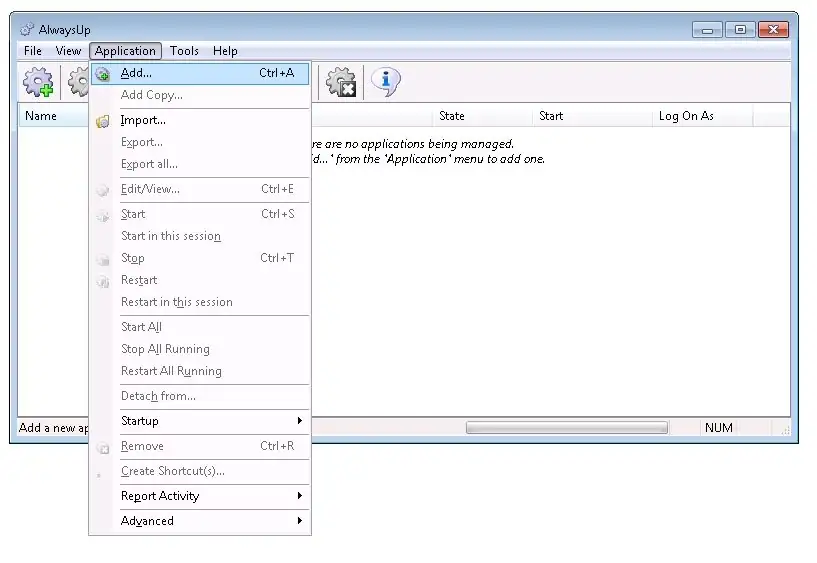-
Download and install AlwaysUp, if necessary.
-
Download, install and configure Gbridge, if necessary.
Please make a note of where you installed it as this will be used in a later step.
-
Start AlwaysUp.
-
Select Application > Add to open the Add Application window:
-
On the General tab:
-
In the Application field, enter the full path to the Gbridge executable, Gbridge.exe.
If you installed Gbridge in the default location, this is:
C:\Program Files\Gbridge LLC\Gbridge\Gbridge.exe
-
In the Name field, enter the name that you will call the application in AlwaysUp.
We have entered Gbridge but you can specify almost anything you like.
-
Click over to the Logon tab and enter the user name and password of the account in which you installed and configured Gbridge.
Gbridge must run in this account so that it can find its settings.
-
Click over to the Startup tab and check the Ensure that the Windows Networking components have started box.
This informs AlwaysUp that the media server needs the TCP/IP networking stack to operate.
-
Click the Save button. In a couple of seconds, an application called Gbridge will show up in the AlwaysUp window.
It is not yet running though.
-
If Gbridge is running, close it now by clicking the Log Off button and selecting Exit from the menu.
AlwaysUp will not be able to start Gbridge properly if it is already running.
-
Starting Gbridge as a service at this stage will run it in Session 0 - the desktop hosting all Windows Services. Gbridge works fine like this on
Windows XP and 2003 but it runs into trouble on Windows Vista, 7, and Server 2008 where
Session 0 is isolated. It seems like Gbridge's tray icon cannot "attach itself" to a task bar and that prevents it from running, but that is only a guess.
In any case, providing a task bar in Session 0 seemed to make Gbridge happy...
Please follow steps 1-8 of this tutorial to provide a task bar in Session 0.
Once complete, start the new Explorer service you created by selecting Application > Start "Explorer".
-
To start Gbridge from AlwaysUp choose Application > Start "Gbridge". Note that you probably won't see Gbridge's tray icon appear as it is running in the background
but communication should proceed normally.
On Windows 7, 2008 or Vista (or when connecting via RDP), choosing Tools > Switch to Session 0... will take you to Session 0 where you can interact with the Gbridge windows and tray icon.
-
Now that Gbridge will start when your computer boots, there is no need to start it again when you log on. We recommend using the
free Autoruns tool from Microsoft to disable Gbridge's auto-start but any "startup manager" should do the trick.
With Autoruns, click over to the Logon tab and un-check the box beside the Gbridge entry:
-
That's it! Next time your computer boots, Gbridge will start up immediately, before anyone logs on.
We encourage you to edit Gbridge in AlwaysUp and check out the many other settings that may be appropriate for your environment.














